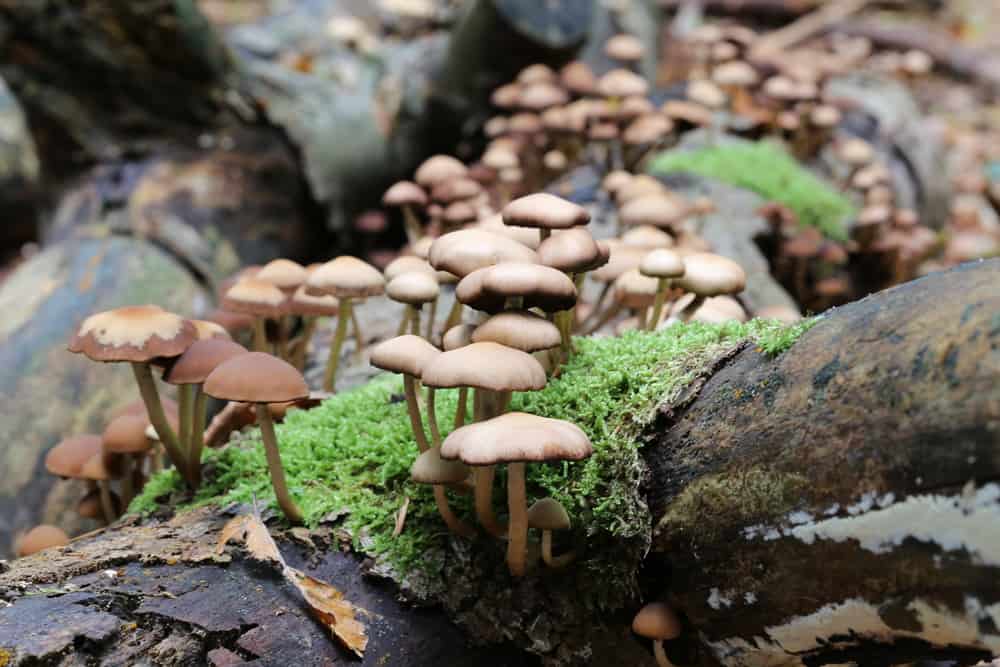 Toadstool vs Mushroom – 10 Differences You Should Know
Toadstool vs Mushroom – 10 Differences You Should Know
Let’s face it. You’re familiar with the terms mushroom and toadstool that are used interchangeably. However, if you’re curious about the difference between the two, you’ve come to the right place.
Read on as we delve into an in-depth comparison of toadstool vs mushroom. You’ll learn about how toadstools differ from their mushroom counterparts, the origin of each, and more. As a mushroom hunter, mushroom identification is key for avoiding toxic mushroom species.
What Is a Toadstool?
It can be defined as a spore-bearing fruiting body, usually as a round cap on a stalk, particularly one that’s believed to be a poisonous mushroom and unfit for consumption. Some toadstool species grow on buried scraps of wood or dead roots.
Although the term ‘toadstool’ solely applies to inedible or poisonous mushrooms, it’s also used to define those that have the classic umbrella shape (dome-shaped cap with a stem) but are edible.
The greater part of the toadstool consists of the stem and cap, whereby the former holds the cap and is usually slender and long or rounded and thick. The surface of the cap might be sticky and moist or covered by dry skin.
A young toadstool has a membrane that stretches from the stem to the edge of the cap, keeping the gills tucked away. As it continues growing, the membrane is torn and remains as a ring enclosing the stem. Some mushroom species have a second membrane known as the volva that encircles the entire toadstool, which also tears once the growth cycle is complete.
The reproduction of the toadstool differs from that of the flowering plants, whereby the ovules are fertilized by pollen grain, ushering in the production of seeds. Usually, toadstools release countless spores from the gills situated at the base of the caps. They are easily mistakable for fine grains of dust as they are tinier than generic seeds.
The wind blows the spores, scattering them everywhere. If they land on fertile ground, the germination process will begin. The spore grows into a primary mycelium (a filament) consisting of a chain of cells set from one end to another.
While merging to form the secondary mycelium, the filaments send branches. The result is an underground network that evolves to form a toadstool that you’ll see above-ground.
Facts About Toadstools
We’ve rounded up a few things you should know about a toadstool.
- Toadstools with a red stem or cap are usually hallucinogenic or poisonous
- Examples of toadstools are Stropharia Aeruginosa, Leccinum Aurantiacum, Amanita Muscaria, Lactarius Torminosus, and Lactarius Deliciosus
What Is a Mushroom?
It can be described as a fungal growth that usually has the structure of a dome-shaped cap supported by a stalk. Gills sit on the underside of the cap, which is the most conspicuous above-ground structure. Nevertheless, it makes up a fraction of the entire fungal body.
Various types of mushrooms are edible. They have been eaten and used for medicinal purposes for centuries. Furthermore, all mushroom species are low in fat and calories, high in nutrients and fiber. Although the term ‘mushroom’ is usually associated with fungi with stalk or stem, gills, and a dome-shaped cap, it’s also used to define a broad range of gilled fungi with or without stalks and, more specifically, any fruity body.
A mushroom stems from a primordium, a small structure that grows on a substrate. It evolves into an egg-shaped structure that consists of hyphae, usually called a button. The universal cover (mycelium) initially engulfs the button.
As the button continues growing, the veil or cover disintegrates. Remnants of the veil on a mature (fully-grown) mushroom typically appear as warts or hang from the cap. While mushrooms differ in appearance with over 500 renowned types, they are generally differentiated by gills on the underside of the cap, a stem, and a meaty, dome-shaped cap.
A wealth of mushroom species seems to appear overnight, growing quickly. However, the truth is that not all species expand overnight. Some mushrooms grow slowly, adding tissue to their fruiting body by inserting hyphae or expansion at the edges of the colony.
Various types of mushrooms are scattered across the globe, with some only growing in particular regions. Temperature is crucial in the distribution of mushrooms that can be categorized under temperate, tropical, and subtropical belts.

Facts About Mushrooms
Let’s discuss a few fun facts about a mushroom.
- You’ll typically find true mushroom species growing in lawns or open paddocks rather than on shrubs and below trees as you would toadstools.
- The external layer of a mushroom cap is usually smooth and brown-white with no conspicuous warts or raised scales. Toadstools, for instance, the dangerous Amanita Muscaria, typically has a red cap that’s littered with raised bumps or scales.
- Types of mushrooms range from Oyster, Porcini, Cremini, Giant Puffball, Lion’s Mane, and Hedgehog to Button.
- The undersurface of the cap of a true mushroom is layered with gills (narrow flanges) that are pink in young mushrooms. Once a mushroom is fully matured (grown), the flanges turn dark brown (almost black). It’s worth noting that poisonous mushrooms or toadstools have gills that remain white throughout their lifecycle.
- The gills of ‘true’ mushroom species are connected to the cap rather than the stalk. Therefore, when the stalk is detached from the base, the gills remain attached to the cap. However, if the gills remain connected to the stalk, it’s not considered a ‘true’ mushroom.
Toadstool vs Mushroom
Let’s discuss a few differences between mushrooms and toadstools.
Description
Mushrooms can be described as a fungal growth that takes the shape of a domed cap with gills underneath and is supported by a stem. On the other hand, a toadstool is the fruiting body of a fungus that bears spores and usually takes the shape of a round cap on a stem, particularly one that is perceived to be poisonous or inedible.
Main Feature
A mushroom cap can be peeled and usually grows on wood. Contrarily, toadstools usually have white gills, a ring or skirt surrounding the stalk, a red cap, and a sack-like (bulbous) base. The stalk might be cream-yellow.
Growth
A mushroom typically grows in lawns or open paddocks rather than on shrubs and under trees like a toadstool. You’ll find most types of toadstools growing above scraps of wood or lumber and dead tree roots.
Edibility
Mushrooms are mostly edible species and non-poisonous, which is why a boatload of types, such as oyster mushrooms, is readily available in grocery stores. Toadstools are inedible, a poisonous species, and hallucinogenic.
Types
Mushroom species include Hedgehog, Porcini, Lion’s Mane, Oyster, Giant Puffball, and Button. Types of toadstools include Lactarius Deliciosus, Stropharia Aeruginosa, Amanita Muscaria, and Leccinum Aurantiacum.
Color
Mushroom species usually have a dark/ brown or white cap, whereas the cap of their toadstool counterparts can be blue, red, green, or yellow. They are more conspicuous
Medicinal Purposes
Mushrooms not only come in handy for medicinal purposes but are also highly nutritious, low in fat and calories, making them the perfect meat substitute or superfood. Toadstools, on the other hand, lack medical purposes and are usually poisonous, with some species triggering hallucinations.
Texture
The exterior of a mushroom cap is typically smooth and white or brown. Toadstools have a textured cap that’s usually red and is filled with raised scales that are white or yellow. A great example is the poisonous Amanita Muscaria.
Gills
Mushroom species have gills tucked in the underside of the cap, whereas toadstools have white gills that can be found on the stem coupled with a bulbous base.
How to Identify a Poisonous Mushroom
- Mushrooms with white gills are usually poisonous. The gills are the part of a mushroom that generate spores and are typically found on the underside of the cap. Additionally, they might be ribbed and comprise a multitude of small holes.
- The presence of a volva, particularly one encircled by a ring, is usually the tell-tale sign that the given mushroom species is poisonous and therefore inedible. The volva refers to the bulging section at the base of the stem. Given that it’s usually underground, foragers might need to dig around the base to check for the volva.
How to Differentiate a Poisonous Toadstool from an Edible One
Not all fungi that resemble a conventional toadstool are poisonous. For instance, there’s no denying Porcini, Morels, and Wine Caps are unique-looking mushrooms that are often mistaken for dangerous toadstools. They are some of the most delicious mushroom species you’ll find and work well in a boatload of recipes.
Likewise, not all fungi that resemble edible mushroom species are safe for consumption. For instance, young Amanitas can resemble Button or Puffball mushrooms even when they’re still expanding and growing. Therefore, refrain from foraging for a wild mushroom to eat unless you have adequate experience to identify them.
Some poisonous mushrooms are difficult to tell apart from their edible counterparts. In some cases, the only thing setting them apart can be a subtle characteristic, such as the color of their spores.
Conclusion
Most people use the terms interchangeably when it comes to toadstool vs mushroom, as there’s no accepted scientific categorization between the two. Therefore, if you’re wondering when to refer to a toadstool as a mushroom and vice versa, it boils down to your preference. After all, some people refer to toadstools as inedible and poisonous mushrooms, especially those with colorful caps.




